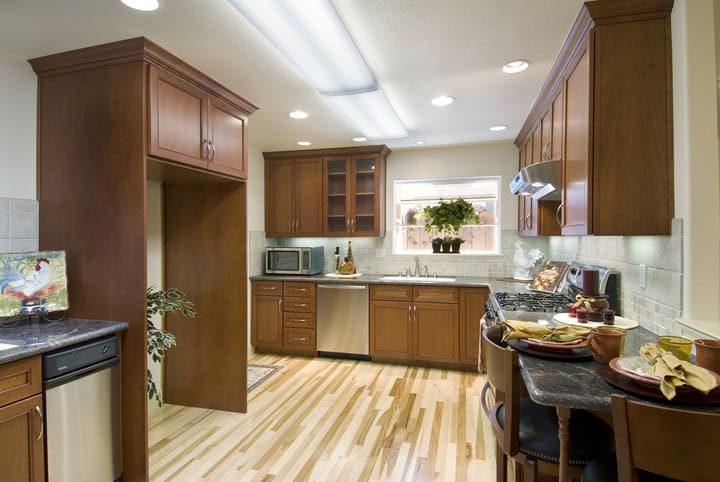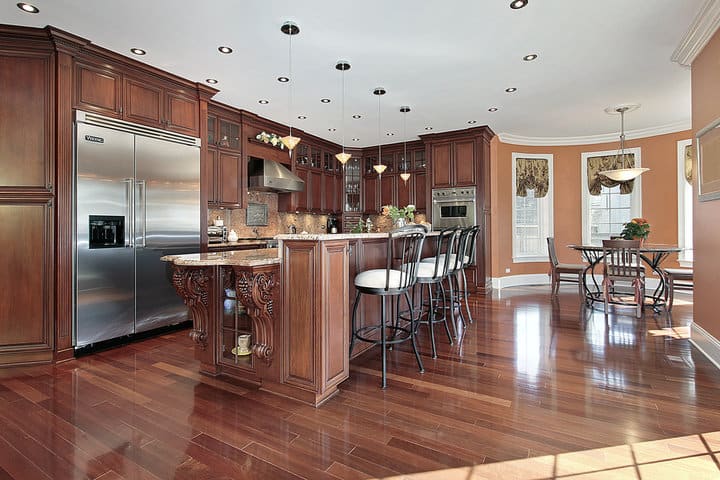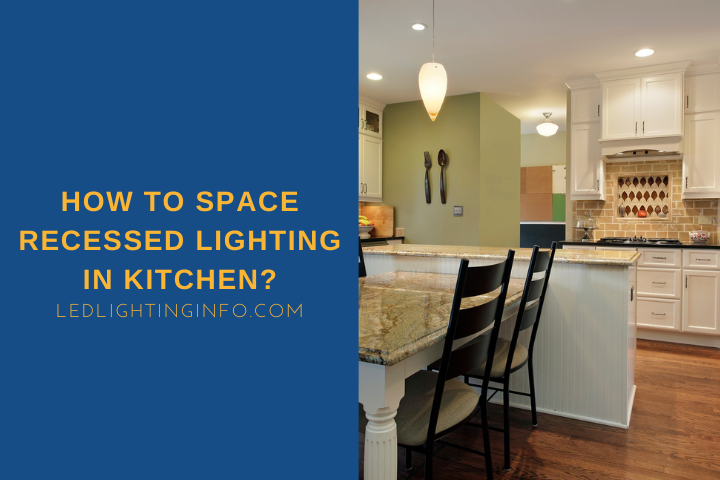Your kitchen is one of the rooms you must pay the most attention to when it comes to lighting.
When you’re in the kitchen, you’ll spend a lot of time using sharp tools and other dangerous implements.
If you can’t see what you’re doing or dim lights cause you to tire and squint, the risk of injury can be high.
So, if you’re planning to install recessed lights in your kitchen, you must plan carefully.
You should use a lighting layout that ensures sufficient light on work surfaces or supplement your recessed lights with another task lighting. Space lights evenly to ensure no dim spots – measure the room and divide the distances between each light.
Since there are a couple of things to consider, let’s delve a little deeper into:
- How far apart recessed lights should be spaced
- Where to place the lights
- How many lights you need
How Far Apart Should LED Recessed Lights Be In The Kitchen?

The distance between your LED recessed lights will depend on the size of your kitchen and, more importantly, the bulbs’ brightness.
While you’ll work out the exact distance between them when you calculate how many recessed lights you need, there are some guidelines on the recommended maximum distance between recessed LED lights that are easy to remember.
For every inch of the fixture, you want to leave no more than a foot between each bulb.
If you’re using 4-inch diameter light fixtures, leave no more than 4 feet between each light.
And if you’re using 6-inch diameter light fixtures, leave no more than 6 feet between each light.
You’ll also need to ensure that you leave the appropriate space between the wall and the lights.
You usually calculate the number of lights you need and then work out the distance between each light.
Then, halve that distance, and that’s how far the lights should be from the wall.
But with a kitchen, you need to factor in any wall units you have.
These should be treated as the wall. If you have cupboards fixed to the wall, measure the distance from the edge of the cupboard, not the wall.
Otherwise, you’ll have lights sitting a very short distance from the cupboard – and those cupboards will block the light from the most important area of the kitchen – the work surfaces below.
Does Ceiling Height Affect Light Density?
A common question with recessed lighting is whether the height of the ceiling impacts light density.
And the accepted answer is – not really.
Because of how recessed lights work, they project light in a cone beneath them. That cone spreads out equally.
The accepted rule for calculating light density and the number of lights considers a standard ceiling height.
With a taller ceiling, the light cones will spread further, meaning better coverage.
In theory, if you had a lower ceiling, then you might need to increase the number of lights, but the standard calculation takes into account a ceiling that’s at a typical height.
Unless you live in a hobbit home, you don’t need to worry as ceilings aren’t built lower.
For taller ceilings, it’s not the density you need to worry about – but you may want to use a brighter bulb.
That’s because, by the time the light reaches the floor, it will have dispersed more and won’t be as bright.
Recessed Lighting Plan: Where Should I Place Them?

Usually, when planning where to place your recessed lights, you’ll just factor in a regular layout – usually a rectangle for a rectangular room or a square formation for a square room.
With kitchens, it’s a little different, as you’ll want to focus the lights on the most critical areas.
So yes, you’ll want a regular pattern that looks neat, but it needs to ensure sufficient lighting above work surfaces.
If you have a dining area in the kitchen, you’ll normally want that to be well-lit too.
The best idea with a kitchen is often to split the room into different sections and treat them differently.
Even if the room is one long even rectangle, this will allow you to focus the light where it is needed most.
Get creative with a light layout. For example, instead of a rectangle, you might use a row of 3, 2, and a final row of 3.
Or you’ll have a 2 x 4 rectangle in the area where you cook and a 2 x 3 rectangle of lights over the dining space.
If you need ideas, then a beneficial inspiration to have to hand is a deck of playing cards.
Look at the layout of the symbols on the cards from 4 to 10, and you’ll see how lights could be spaced out evenly.
How Many Recessed Lights Do I Need In The Kitchen?

There’s a simple formula to work out how many lights you need in the kitchen – and this will tell you how far apart you should space them too.
What you need to do is measure the area of the room. Not the volume – just the flat area – length by width.
Do this in feet, and then multiply it by 1.7. The formula is adaptable for other rooms, too – you can multiply by 1.5 for living rooms and bedrooms – but use 1.7 as your multiplying factor for kitchens (and bathrooms).
Then, you would normally divide this by the wattage of the bulb you’re using. But for LED recessed lights, you divide by the equivalent wattage.
So for an 8-watt LED bulb, the equivalent wattage usually is 60.
You can usually find the equivalent wattage on the lightbox or the product description.
That’ll tell you how many lights you need. Then decide on your layout, and you can use that info to work out how to space them.
Equally, divide the room’s length by the number of bulbs, which tells you how much space to leave between each light.
Half the distance for the measurement from the wall/cabinets to the lights.
Repeat for the width, and you have your spacing measurements.
Alternatively, you can use my recessed lighting calculator, to make things even easier.
Final Words
It’s essential to make sure you space your lights out evenly in any room. Otherwise, the ceiling will look like a mess.
But it’s even more vital in a kitchen or any other room that is filled with hazards.
Take the time to measure the room carefully, and keep a lot of notes and drawings – check them regularly to keep yourself on track.
But then, if you use the guidance I’ve provided, making sure the work surfaces are well lit and that you don’t spread lights out too far, the project won’t be too tricky.
Have you encountered any issues with lighting a kitchen using recessed lights?
What layout did you choose for the fixtures?
Looking for an LED bulb but not sure what type you need?
Check out my free bulb picker and select the right bulb within few clicks.

